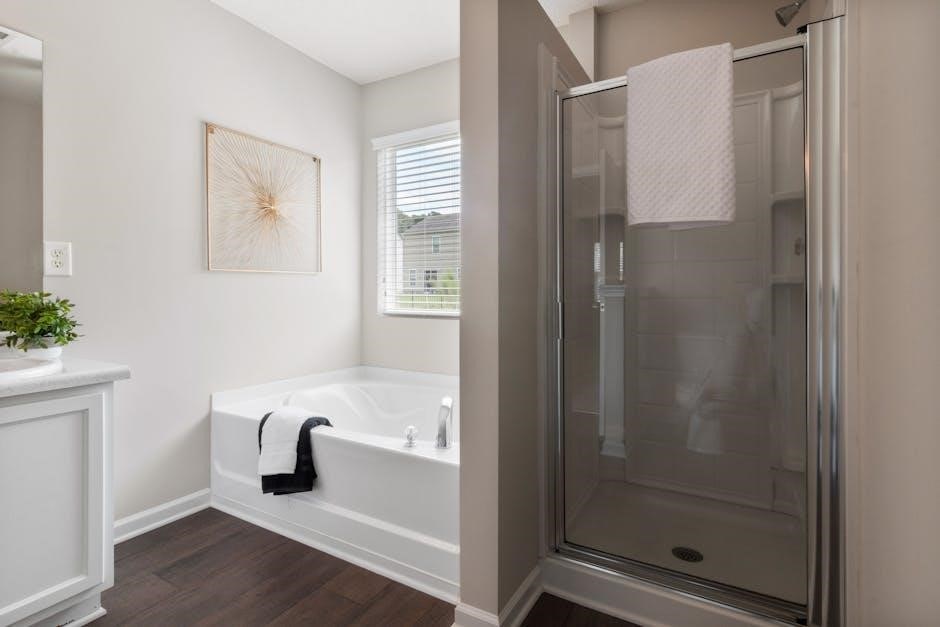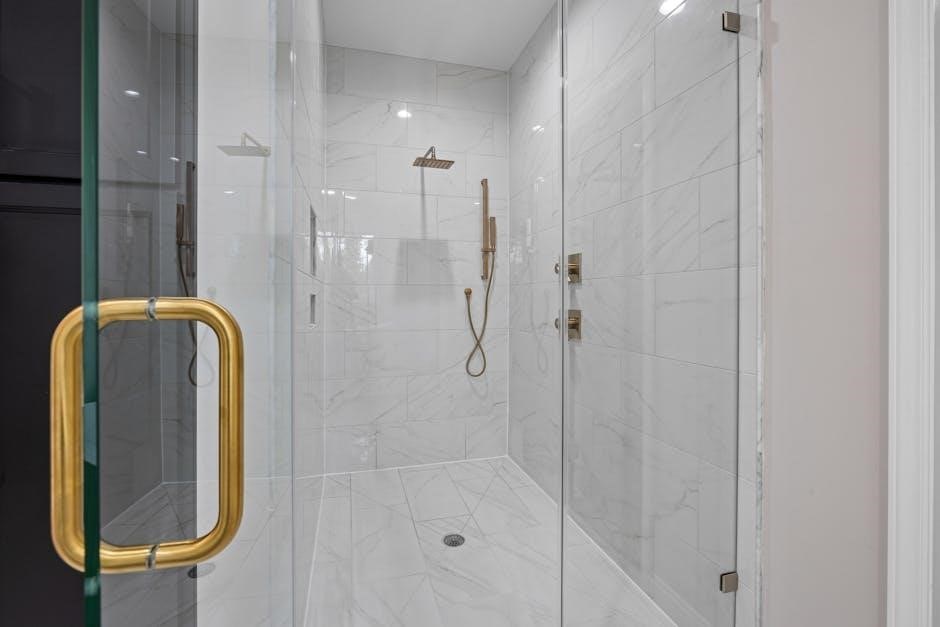Shower Door Bottom Guide Replacement: A Comprehensive Guide
Learn how to replace your shower door bottom guide effectively․ This guide covers tools, materials, and step-by-step instructions to ensure a smooth and successful installation process․
A shower door bottom guide ensures proper alignment and smooth operation of your shower door, preventing water leakage and enhancing durability․ It’s a small but crucial component that, when worn out, can cause significant issues․ Replacing it promptly maintains your shower’s functionality and appearance․
What is a Shower Door Bottom Guide?
A shower door bottom guide is a small, often vinyl or rubber component attached to the shower door or frame․ It helps keep the door aligned, preventing it from swinging unevenly or sagging․ This guide ensures the door closes properly, reducing water leakage and wear on hinges․ Over time, it can become worn or damaged, leading to misalignment and functional issues․ Replacement is typically straightforward, with guides available as universal or specific fits, depending on your shower door type․
Why Replace the Shower Door Bottom Guide?
Replacing the shower door bottom guide is essential for maintaining proper door alignment and preventing water leakage․ Over time, the guide can wear out, causing the door to sag or swing unevenly, which may lead to frame damage․ A damaged guide can also allow water to seep through, creating slippery floors and potential mold growth․ By installing a new guide, you ensure smooth door operation, reduce maintenance needs, and enhance bathroom safety․ It’s a simple fix that improves functionality and extends the lifespan of your shower door system․ Regular replacement helps maintain a clean, efficient, and secure bathroom environment․

Tools and Materials Needed for Replacement
- Screwdriver or Allen wrench for removing screws
- WD-40 to loosen stuck parts
- Putty knife for scraping old adhesive
- New shower door bottom guide
- Adhesive or double-sided tape
- Silicone sealant for waterproofing
Essential Tools for the Job
To replace the shower door bottom guide, you’ll need a few essential tools․ Start with a screwdriver or Allen wrench to remove screws holding the old guide․ WD-40 can help loosen stuck parts․ A putty knife is handy for scraping away old adhesive or caulk․ For measuring and aligning, a tape measure and level are useful․ If the guide is held by double-sided tape, a utility knife can assist in careful removal․ Finally, a clean, dry cloth will help prepare the surface for the new guide․ These tools ensure a smooth and efficient replacement process․ Gather them beforehand to avoid delays․
Materials Required for Installation
The materials needed for installing a new shower door bottom guide are straightforward․ First, purchase a replacement guide that fits your door model․ Ensure it’s made of durable materials like vinyl or rubber for longevity․ You may also need new screws or adhesive strips if the old ones are damaged․ Silicone sealant can help create a watertight seal․ For cleaning, gather a foam bathroom cleaner and a wet cloth․ Optional items include double-sided tape for extra stability and a lubricant like WD-40 to ease installation․ Having these materials ready ensures a quick and effective replacement process․ Always check compatibility before purchasing․

Step-by-Step Installation Process
Replace your shower door bottom guide by removing the old one, preparing the door and frame, installing the new guide, and ensuring proper alignment for smooth operation․
Removing the Old Bottom Guide
Start by inspecting the shower door bottom guide to determine how it’s secured․ If screws are visible, use a screwdriver to remove them․ Apply WD-40 if screws are stuck․ For guides held by caulk or adhesive tape, carefully insert a putty knife under the edge and gently pry it loose․ Work slowly to avoid damaging the shower frame or door․ Once the old guide is removed, clean the area thoroughly to prepare for the new installation․ Always wear gloves to protect your hands during this process․
Preparing the Shower Door and Frame
Before installing the new bottom guide, ensure the shower door and frame are properly prepared․ Clean the area where the old guide was removed, using a mild detergent and a dry cloth to remove any residue or moisture․ If the door is still attached, consider removing it temporarily for better access․ Inspect the frame for any damage or uneven surfaces and address these issues to ensure a smooth installation․ Align the door and frame correctly to maintain proper functionality․ Once the area is clean, dry, and even, you’re ready to install the new bottom guide․
Installing the New Bottom Guide
Begin by peeling the backing from the new bottom guide’s adhesive strip․ Align it with the shower door frame, ensuring it matches the position of the old guide․ Press firmly to secure it in place․ If screws are required, use a screwdriver to tighten them gently․ Ensure the guide is flush with the frame and properly aligned to support the door’s movement․ Double-check the fit to avoid any gaps or misalignment․ Once installed, test the door’s operation to confirm smooth sliding and proper closure․ A secure and even installation ensures longevity and prevents water leakage or door misalignment issues․
Ensuring Proper Alignment and Function
After installing the new bottom guide, inspect its alignment with the shower door frame․ Ensure it is flush and evenly positioned to support the door’s movement․ Gently test the door by sliding it back and forth to confirm smooth operation․ Check for any gaps or wobbling, which could indicate misalignment․ If necessary, adjust the guide slightly, ensuring it remains securely fastened․ Once aligned, test the door’s ability to close properly and prevent water leakage; Proper alignment ensures the door functions seamlessly, reducing wear and tear on the guide and extending its lifespan․ Regularly inspect and adjust as needed to maintain optimal performance․
Additional Tips and Considerations

Regularly clean the bottom guide to prevent mold and mildew buildup․ Inspect for wear and tear, and ensure the guide fits snugly to maintain proper door alignment․
Common Mistakes to Avoid
When replacing a shower door bottom guide, avoid using excessive force, which can damage the frame or strip the screws․ Ensure the new guide is compatible with your door’s make and model to prevent alignment issues․ Not cleaning the area properly before installation can lead to poor adhesion or uneven fitting․ Applying too much caulk or adhesive may cause the guide to stick improperly․ Ignoring manufacturer instructions can result in a faulty installation․ Additionally, failing to test the door’s movement after installation can lead to ongoing issues with alignment and functionality․ Proper preparation and careful execution are key to a successful replacement․
Maintenance Tips for Longevity
Regularly clean the bottom guide with a mild detergent to prevent soap scum and mildew buildup, ensuring smooth door operation․ Inspect the guide periodically for wear or misalignment and adjust as needed․ Avoid using abrasive cleaners or tools, as they may damage the material․ Dry the guide thoroughly after cleaning to prevent water spots․ Lubricate moving parts with a silicone-based spray to maintain ease of movement․ Replace worn-out or damaged components promptly to prevent further issues․ By following these maintenance tips, you can extend the lifespan of your shower door bottom guide and ensure optimal functionality over time․

Troubleshooting Common Issues
Identify common problems like misalignment, sticking, or noise․ Check for proper installation, clean debris, and ensure the guide is securely fastened․ Adjust or replace parts as needed․
Diagnosing Problems with the Bottom Guide
Begin by inspecting the bottom guide for visible damage or wear․ Check for misalignment by observing how the shower door moves along the track․ If the door sticks or makes noise, the guide may be faulty․ Look for mineral buildup or debris accumulation, which can hinder smooth operation․ Test the guide’s stability by gently tugging on it; if it feels loose, it may need tightening or replacement․ Ensure the track is clean and free from obstructions, as dirt can cause friction and affect functionality․ Proper diagnosis is key to addressing the issue effectively and ensuring the door functions seamlessly․
Solutions for Common Installation Issues
For misaligned guides, adjust the screws or reposition the track․ If the guide is loose, tighten the screws or replace the adhesive․ Clean the track thoroughly with a putty knife and bathroom cleaner to remove dirt and old adhesive․ Apply a small amount of silicone spray to reduce friction․ Ensure the door is removed before installation to prevent weight interference․ Use WD-40 to loosen stubborn screws․ Measure twice and align carefully to avoid crooked placement․ If the guide doesn’t fit, check for correct sizing or consider using adjustable models․ Proper preparation and alignment ensure a smooth, hassle-free installation process․
Replacing the shower door bottom guide is a straightforward process with the right tools and knowledge․ Ensure proper functionality and longevity by following the steps carefully and maintaining regular cleanliness․
Final Thoughts on Replacement and Maintenance
Replacing your shower door bottom guide is a simple yet crucial task to maintain proper door alignment and functionality․ Regular cleaning of the guide with a foam bathroom cleaner can extend its lifespan․ Ensure the track is free from debris and calcium buildup to prevent issues․ When installing a new guide, double-check alignment to avoid future problems․ Many customers find the process quick, with some replacements taking less than five minutes․ For durability, select a sturdy, well-fitting guide that suits your shower door type․ Proper maintenance and timely replacements will keep your shower door operating smoothly and enhance your bathroom experience long-term․
